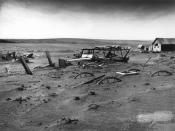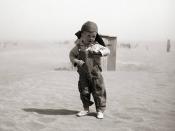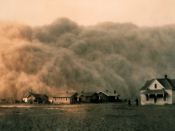Before the 1930's as the rain fell steadily, farmers in the Great Plains were planting and harvesting abundant crops. They had no idea of the damage being done as they planted crops year after year. This left the soil unconfined and bare. The once grass-covered fields were stripped away from cows grazing and sheep herding. No one knew these factors would lead to almost a decade of devastating events. In 1930 the first drought hit along the east coast, and was then followed by a series of droughts that affected mostly the southern Plains. Strong winds carried dust across the Great Plains and filled the air with billowing clouds of sand and soil. No grass remained to hold the soil in its place. This time period of drought and dust storms became known as the Dust Bowl. The states of Texas, New Mexico, Colorado, Kansas, and Oklahoma were most highly affected, but the surrounding states were also hit with the same drought and saw the dust fill the air.
The Dust Bowl struck many Americans with poverty and disease, sent many families west in search for a better life, opened the eyes of the government to the need for help, and changed their lives forever.
To begin, the dust storms had a huge effect on the daily lives of those whom the dust storms reached. As the soil was being flung into the air, it became impossible to plant sufficient crops, if any at all. This left many farmers without a job or means of support. Besides the unemployment, daily life was harsh as dust filled the sky daily and was impossible to be kept out of the house. "The skys could darken for days, and even the most well sealed homes could have a thick layed of dust...


